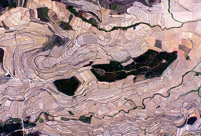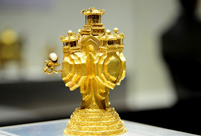

If you thought the Northern Lights were impressive on Earth, think again.
Jupiter has its own version of our aurora but it is so high energy that it is made up of X-rays instead of visible light.
When triggered by a solar storm, Jupiter's aurora can cover an area larger than the Earth's surface.
If you thought the Northern Lights were impressive on Earth, think again. Jupiter has its own version of our aurora but it is so high energy that it is made up of X-rays instead of visible light. Jupiters X-ray emission (in magenta and white, for the brightest spot) are seen in these images
For the first time, a research group led by UCL has looked at what happens to Jupiter's X-ray aurora when a giant solar storm arrives at the planet.
The study, published today, has described the group's findings that were made from data collected at Nasa's Chandra X-Ray Observatory, a space observatory that was launched in 1999.
The researchers discovered that solar storms trigger Jupiter's intense 'Northern Lights' by generating a new X-ray aurora that is eight times brighter than normal.
'They are hundreds of times more energetic and much much bigger than Earth's,' lead author and PhD student at UCL Mullard Space Science Laboratory, William Dunn told MailOnline.
For the first time, a research group led by UCL has looked at what happens to Jupiter's X-ray aurora when a giant solar storm arrives at Jupiter. CGI pictured. The study, published today, has described the group's findings that were made from data collected at Nasa's Chandra X-Ray Observatory
'Earth's surface would comfortably fit inside Jupiter's aurora. Whereas the chemistry in Earth's atmosphere is controlled largely by the sun, Jupiter's aurora are so bright and powerful that it is them that control the chemistry in Jupiter's atmosphere, much more than the sun does.
'So if you looked up from Jupiter into the sky, you would see the aurora stretch across the sky as far as the eye could see and it would be much brighter than the sun, even during the day.
'If your eyes could see the X-rays you would also see it pulsing, going very bright and then very dim every 45 minutes or, if a solar storm was occurring, every 26 minutes. It's also quite warm because it gives off lots of infra-red radiation.
'There's a constant power struggle between the solar wind and Jupiter's magnetosphere,' said Mr Dunn.
'We want to understand this interaction and what effect it has on the planet.
'By studying how the aurora changes, we can discover more about the region of space controlled by Jupiter's magnetic field, and if or how this is influenced by the sun.
'Understanding this relationship is important for the countless magnetic objects across the galaxy, including exoplanets, brown dwarfs and neutron stars.'
The sun constantly ejects streams of particles into space in the solar wind.
When giant storms erupt, the winds become much stronger and compress Jupiter's magnetosphere, shifting its boundary with the solar wind 1.2 million miles (2 million km) through space.
The study found this interaction at the boundary triggers the high energy X-rays in Jupiter's 'Northern Lights', which cover an area bigger than the surface of the Earth.
 |
 Thai most beautiful transgender Nong Poy release new photos
Thai most beautiful transgender Nong Poy release new photos Now and then photos of Shanghai Jiaotong University
Now and then photos of Shanghai Jiaotong University Is this what air travel will look like in 2050?
Is this what air travel will look like in 2050? Aerial view of watermelon terraces in S China's Baise
Aerial view of watermelon terraces in S China's Baise Traditional wedding of a post-80s Tibetan couple
Traditional wedding of a post-80s Tibetan couple Models in cheongsams present classical oriental beauty
Models in cheongsams present classical oriental beauty Second commissioned C28A corvette made by China enters Algerian Navy
Second commissioned C28A corvette made by China enters Algerian Navy Intoxicating Wuyuan in spring
Intoxicating Wuyuan in spring Gold and silver wares of Qing Dynasty exhibited in Shenyang Imperial Palace
Gold and silver wares of Qing Dynasty exhibited in Shenyang Imperial Palace Top 20 hottest women in the world in 2014
Top 20 hottest women in the world in 2014 Top 10 hardest languages to learn
Top 10 hardest languages to learn 10 Chinese female stars with most beautiful faces
10 Chinese female stars with most beautiful faces China’s Top 10 Unique Bridges, Highways and Roads
China’s Top 10 Unique Bridges, Highways and Roads Brussels attacks expose vulnerable Europe
Brussels attacks expose vulnerable Europe Govt mulls ways to curb forex speculation
Govt mulls ways to curb forex speculation Without proper pensions, 46 mln elderly migrant workers cannot retire
Without proper pensions, 46 mln elderly migrant workers cannot retire Countries across the world have begun pasting graphic images on their cigarettes – why China isn’t likely to follow suit
Countries across the world have begun pasting graphic images on their cigarettes – why China isn’t likely to follow suitDay|Week